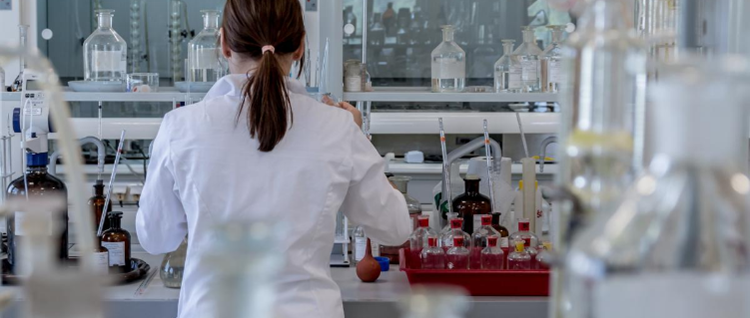 A woman works in a research lab. (Photo from Canva)
A woman works in a research lab. (Photo from Canva)
 It has been 217 days since the first case of COVID-19 was detected in the United States and 166 days since the World Health Organization (WHO) characterized the disease as a global pandemic. During this brief period, the virus has had a dramatic impact on our day-to-day lives, causing 809,000 deaths globally—177,000 deaths in the United States—requiring the shutdown of businesses and schools, and resulting in 28 million unemployed Americans.
It has been 217 days since the first case of COVID-19 was detected in the United States and 166 days since the World Health Organization (WHO) characterized the disease as a global pandemic. During this brief period, the virus has had a dramatic impact on our day-to-day lives, causing 809,000 deaths globally—177,000 deaths in the United States—requiring the shutdown of businesses and schools, and resulting in 28 million unemployed Americans.
The pain and distress caused by this disease has been exacerbated in the United States by the nation’s disappointing public health response. While many of the most affected countries have been able to bring down their cases and begin to return to normal business, the United States has experienced a prolonged period of high infection rates. The reality of the situation is that we are not yet able to restore normalcy.
For the research enterprise, the effects have been widespread. Scientists from all sectors have curtailed their research programs. Many academic scientists have closed their laboratories or reduced their work hours and student researchers have put projects on hold. A recent survey tracking the effects of the pandemic on scientists’ workload published in Nature Human Behaviour (NHM), and covered by Science, shows that just one month after the WHO declared COVID-19 a pandemic, scientists overall had reduced their research hours by 16 percent. Travel for research conferences and data collection has been cancelled and funding cycles for research grants have been disrupted. It will likely take years to determine the overall effects that COVID-19 has had on scientific progress and the research community.
While efforts are underway to return to normal by reopening businesses, colleges, and universities, cluster outbreaks have set back plans to fully restore research activities. Furthermore, the failure to contain the spread of the virus has extended school closures into the fall, resulting in disproportionately negative impacts on scientists who have young children who may be attending online classes from home or whose families may not have the option or feel comfortable using daycare facilities. According to the NHM paper, scientists with children ranging from newborns to 11-year-olds reported a reduction in work hours ranging from 32 percent to 38 percent, depending on the age of their children.
“All else being equal, female scientists reported a 5 percent larger decline in research time,” the authors wrote. “But the most important variable of all appears to be having a young dependent: scientists with at least one child five years old or younger experienced a 17 percent larger decline in research time, all else being equal. Having multiple dependents is associated with a further 3 percent reduction in time spent on research.”
To ascertain the impact of the pandemic on women scientists, consider a study that compared the gender distribution of authors on medical research papers related to the pandemic with papers published in the same journals in 2019. The results, which were published in eLife, estimated that papers with a woman first author in 2020 was 19 percent less than it was in 2019. This result appears to be linked to the role women play in the home. Scientific American reported on an Understanding America Survey of 5,900 adults, that showed 33 percent of employed mothers responded that they have been primarily responsible for providing childcare during COVID-19 school closures, compared with only 7 percent of employed fathers.
These disruptions come at a time when major efforts are underway to recruit and retain women and underrepresented minorities in STEM fields. Evidence supports that a diverse workforce is both a social justice accomplishment and an overall benefit to innovation. Given the disproportionate effects of COVID-19 on women in the research workforce, the scientific community has a responsibility to consider what systemic changes will be necessary to ensure that the pandemic does not reverse promising trends related to women’s advancement in STEM fields. Without deliberate actions to counter these disruptions, we run the risk of reintroducing biases that have excluded women and other minorities from the STEM fields throughout history.
Federal agencies, universities, industry, and government laboratories may need to undertake internal reviews of their policies and processes to reconfigure professional performance evaluations, tenure considerations, promotions, and grant awards under the current circumstances. Sigma Xi is prepared to engage at any level to help address these issues or to broker discussions on these topics.
What is your institution doing to help researchers, employers, and administrators deal with these new challenges? Please let us know in the comments below if there are successful steps being taken by your institution so that we may share them with others who are exploring solutions to these challenges.
Related Reading
Coronavirus Lockdown Lessons from Single-Parent Scientists
Source: Nature
Pandemic Hits Scientist Parents Hard
Source: Science
Scientist Mothers Face Extra Challenges in the Face of COVID-19
Source: Scientific American
Impact of COVID-19 on Academic Mothers
Source: Science
Six Ways to Juggle Science and Childcare from Home
Source: Nature
Jamie Vernon is the executive director and CEO at Sigma Xi, The Scientific Research Honor Society, and publisher of American Scientist.